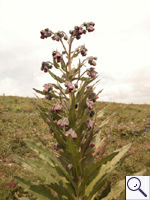|
||||||
|
CYNOGLOSSUM. Hound's-toungues. [Boraginaceae] |
|
|
Five species of Cynoglossum are recorded in Britain. These include the native Green Hound's-tongue (C. germanicum) and Hound's-tongue (C. officinale). Green Hound's-tongue (C. germanicum) is protected under Schedule 8 of the Wildlife and Countryside Act, 1981. Four British miers are recorded on Cynoglossum. A key to the European miners recorded on Cynoglossum is provided in Bladmineerders van Europa. |
|
Key for the identification of the known mines of British |
1a > Leaf-miner and case-bearer: The larva lives outside the mine, protected by a case, and feeds on the underlying plant tissues via a hole cut in the epidermis. From that point it eats away as much leaf tissue as it can reach without fully entering the mine. Mine does not contain frass (Coleophora species). The larva feeds in a distinctive case made from hairy leaf fragments of the foodplant. The young larva feeds on the developing seeds and hibernates in its first case which is made of the tip of a petal. After hibernation it makes a hoary, laterally flattened composite leaf case (resembling a willow catkin). Full depth mines are made at the margin of the leaves, that thereby look peculiarly damaged. Mouth angle 70°. Initially forms a blotch mine, in the centre of a leaf, which it excises for its initial case. In the spring it repeatedly extends its case and it resembles a jagged catkin of willow. The larva may wander from its foodplant and attach to other plants or fences etc. |
|
Coleophora pennella (Denis & Schiffermüller, 1775) [Lepidoptera: Coleophoridae]. |
1b > Leaf-miner: Mine upper-surface or, more often, lower-surface. At first a long, narrow, winding epidermal gallery with central, more or less deliquescent, reddish brown frass. The gallery abruptly widens into an elongate blotch that is epidermal at first but soon deeper; the blotch is brown with strikingly white margins. Epidermis finely wrinkled. Lower surface mines strongly contract the leaf (and often there is a mine at either side of the midrib). 2-3 Larvae in a blotch, each with its own initial corridor. Frass in large black grains in a central depot; moreover in the form of very thin threads stuck in a reticulate pattern in the epidermis. |
|
Dialectica scalariella (Zeller, 1850) [Lepidoptera: Gracillariidae]. |
1c > Leaf-miner: A large, irregular blotch mine with a short linear section in the first instar which is frequently entirely enveloped in the fully developed mine and may then be no longer visible (Spencer, 1976: 124). Perhaps the only character differentiating it from abiens is the presence of several larvae in a fully developed mine of abiens and just one in myosotidis. Puparium reddish brown |
|
Agromyza myosotidis Kaltenbach, 1864 [Diptera: Agromyzidae]. |
1d >Leaf-miner: A narrow linear leaf-mine, which developes into a large blotch. Several larvae frequently feed together and the resulting mine can entirely fill the leaf (Spencer, 1976: 89). The mine begins with a narrow, parallel sided corridor af 1-8 cm in length, with a nice double frass line. After the first moult the corridor is succeeded, and mostly overrun, by a large, primary, brown blotch. Frass in the initial corridor in short thread fragments, in the blotch in angular granules and thread fragments that often are branching (the frass is unusally sticky). Primary and secondary feeding lines conspicuous. The final mine often is very large and generally contains several larvae, because normally several mines develop on a leaf, and coalesce into one big blotch. Before pupation the larvae leave the mine through a semicircular exit slit that mostly, but not invariably, is in the upper epidermis. The initial narrow gallery contains frass in a double line. It then expands to form a blotch mine. Several larvae may occupy a leaf to form a large blotch. |
|
Agromyza abiens Zetterstedt, 1848 [Diptera: Agromyzidae]. |
| Last updated 03-Jul-2019 Brian Pitkin | ||

